This page contains affiliate links. Please read our disclosure for more info.
Planning a trip to Iceland is more complicated than to many countries. With its stunning volcanoes, lava fields, fjords, beaches, and waterfalls, it’s no wonder that visitor numbers to Iceland have surged in recent years.
But many tourists underestimate how dangerous this wild and remote island can be.
Some take unnecessary risks and end up needing to be rescued, which is putting strain on Iceland’s volunteer rescue service. Visitors have even been injured or killed after accidents on glaciers, beaches, and cliffs.
This can be avoided, though, and there’s no reason you can’t have a wonderful, incident-free trip by following these Iceland travel tips.
I also include advice for making the most of your vacation in this beautiful country, quirky facts that make Iceland such a unique place to travel, and the latest travel restrictions.
Contents
- Video: Planning an Iceland Vacation
- When is the Best Time to Visit Iceland?
- How Long Should You Spend in Iceland?
- What’s the Best Way to Travel in Iceland?
- Before You Arrive in Iceland
- Planning a Trip to Iceland: Dos and Don’ts
- DO:
- DON’T:
- More Iceland Reading
Video: Planning an Iceland Vacation
When is the Best Time to Visit Iceland?
I would happily visit Iceland at any time of year as each season offers a different experience.
Summer
Many people consider the summer months of June to August the best time to visit Iceland.
This is when the weather is warmest, although that doesn’t mean it’s hot. In Reykjavik average temperatures in July range from 9 – 14ºC (48 – 57ºF) and it can be colder in the north.
Summer is the time of the midnight sun with daylight hours ranging from 21 hours in late June to 18 hours in early August.
This is the best time of year for hiking, driving the Ring Road (as roads are clear), and seeing whales and puffins. Most attractions and cafes are open.
The downsides of visiting Iceland in the summer are that it’s much busier and more expensive.
Spring and Autumn
To avoid the crowds and high prices, it’s worth considering visiting in the shoulder season months of April/May (spring) and September/October (autumn).
The weather is cold at this time of year but not as extreme as the winter and there’s a good amount of daylight for exploring.
It’s also possible to see the northern lights in these months, although you’ll have more of a chance in April and October.
The downside is that some attractions and cafes are closed.
We loved visiting Iceland in late September when it wasn’t very busy.
We had around 12 hours of daylight and temperatures of –2ºC (28ºF) to 5ºC (40ºF). We enjoyed autumn colours in some locations, the first snowfall on the mountains, and even the northern lights.
See my guide to visiting Iceland in September for more on what to expect.
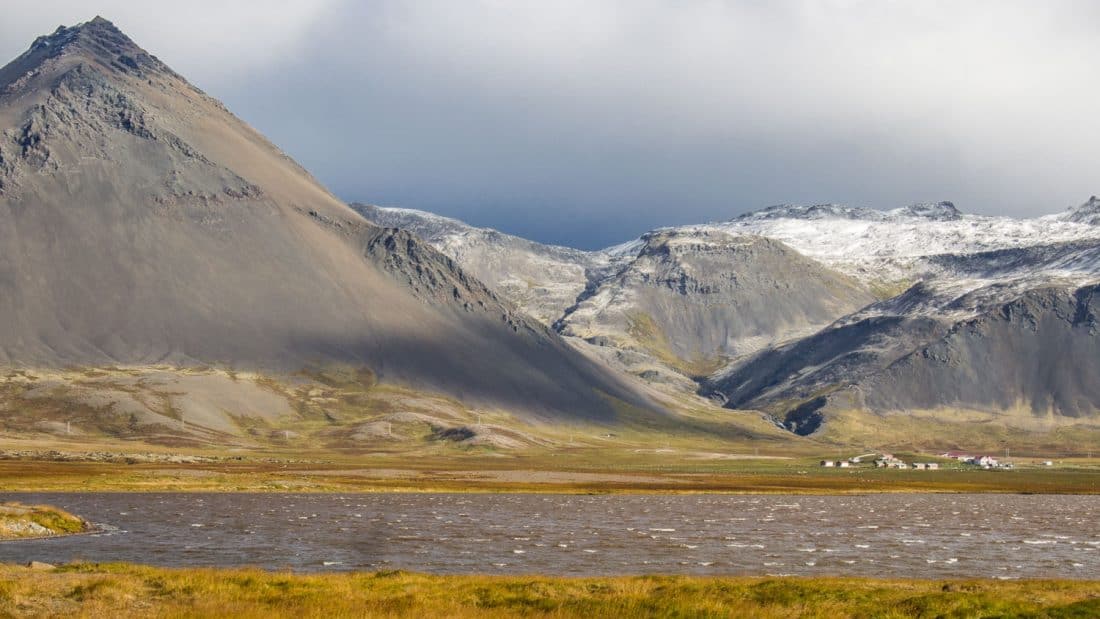
Winter
Iceland’s winter from November to March is the quietest and cheapest time of year to visit.
This is the best time of year to visit Iceland for the northern lights, beautiful snowy landscapes, and winter activities like ice caves and dog sledding.
The weather is cold but not as cold as you’d expect (around 0ºC/ 32ºF) and daylight is limited for exploring (only four hours in late December/early January).
The roads are often covered in snow and not all parts of the island are accessible at this time of year—it’s best to stay south. If you aren’t a confident driver, stay in Reykjavik and take tours.
How Long Should You Spend in Iceland?
The average length of stay in Iceland is around seven nights.
I recommend visiting for at least five nights—this is enough time to see some of the highlights within a few hours of Reykjavik such as the Golden Circle and Snaefellsnes Peninsula.
If you want to drive the entire 1332km (828 miles) Ring Road, which circumnavigates the island, the minimum time needed is one week. 10-14 days would be much better, though.
We visited Iceland for 12 nights and liked not being too rushed. We were able to have a couple of rest days when the weather was bad. See our western Iceland itinerary for details of where we went.
What’s the Best Way to Travel in Iceland?
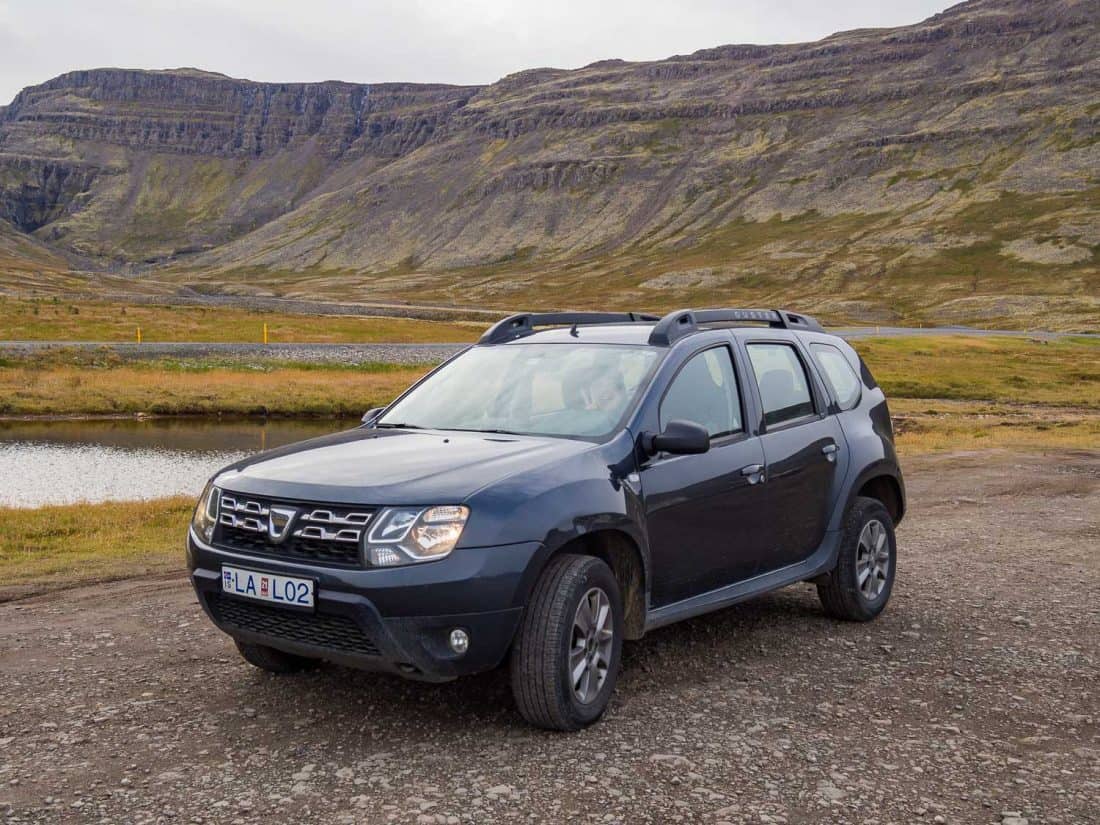
Public transport is very limited so the best way to tour Iceland is with your own vehicle.
Rent a Car
If you can drive, the best way to see Iceland is to hire a car and do a self-drive trip around the island.
We use Booking.com Car Rentals to find the best deal. We rented a 4WD car, which we appreciated on bumpy gravel roads in the Westfjords, but it isn’t strictly necessary for most Iceland trips.
We found driving around Iceland easy—there aren’t many roads so it’s difficult to get lost and there’s good cell phone signal for using Google Maps.
Renting a campervan is also a popular way to tour Iceland in the summer. You must park in designated camping zones, though.
Take Tours from Reykjavik
Another way to explore Iceland is to base yourself in Reykjavik and take day tours. You can get a shuttle bus from the airport into the city (which is very walkable).
See Get Your Guide for a wide variety of trips such as the popular Golden Circle tour, whale watching on a luxury yacht, Jökulsárlón Glacier Lagoon, Sky Lagoon geothermal pool, and many more.
This is the best option if you can’t or don’t want to drive or are visiting in winter and aren’t confident driving on snowy roads. It’s also a good way to travel if you are visiting Iceland on your own.
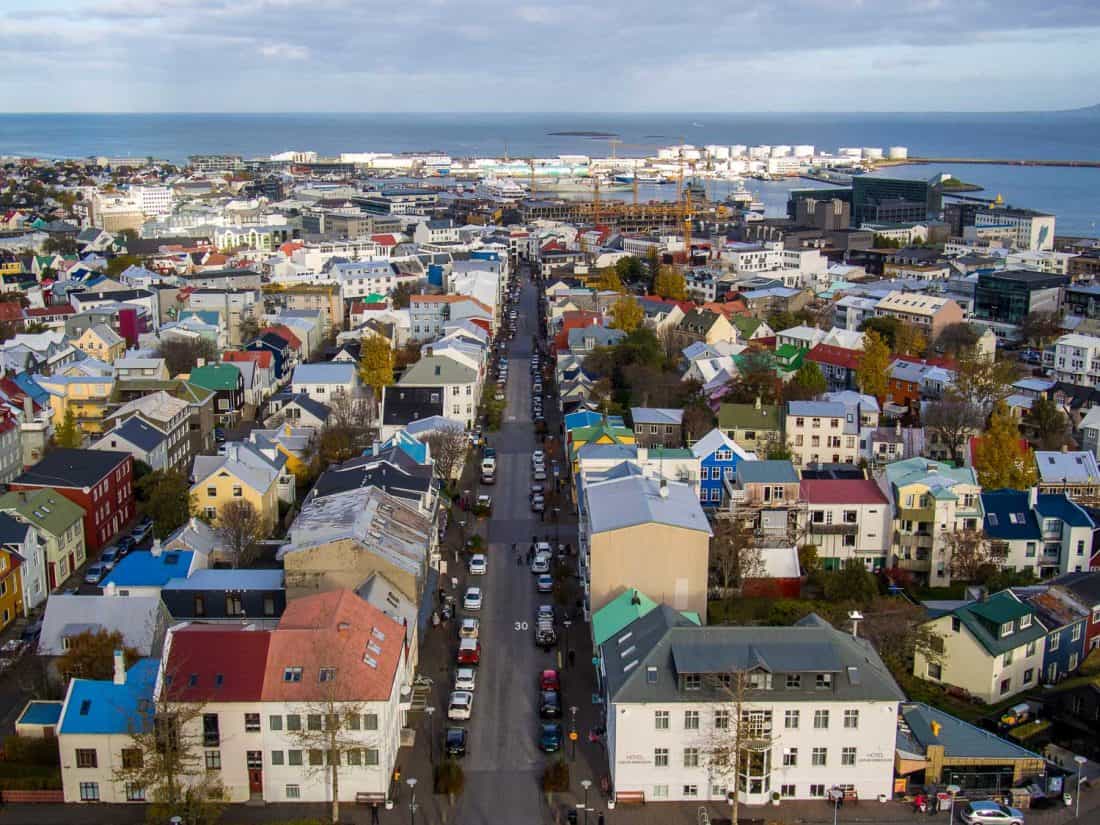
Before You Arrive in Iceland
- Save up – Iceland is expensive and you’ll enjoy your vacation more if you aren’t worrying about every penny (on chilly days we really appreciated those hot chocolate and cake breaks). Find out how much our Iceland trip cost.
- Consider visiting in the off-season – Iceland gets very busy in the June to August summer months, so avoid the crowds by visiting at a different time of year.
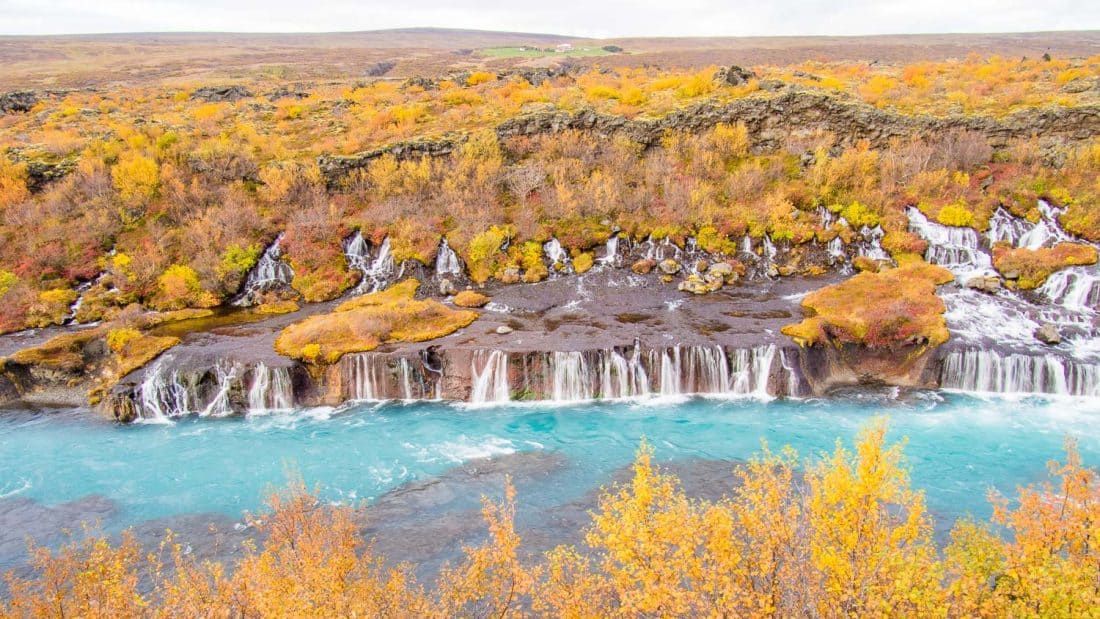
- Plan your itinerary – See our off the beaten track Iceland itinerary for trips of 7 to 12 days or follow the classic ring road around the country (at least 10 days is recommended). Roads in the north are often impassable in winter so stick to the south—here’s a 5 day Iceland winter itinerary.
- Book your accommodation – Especially if you are travelling in the summer high season, you need to book far in advance. You can use sites like Vrbo to find self-catering cabins and save on high restaurant costs. Search on Booking for hotels, guesthouses, and cottages.
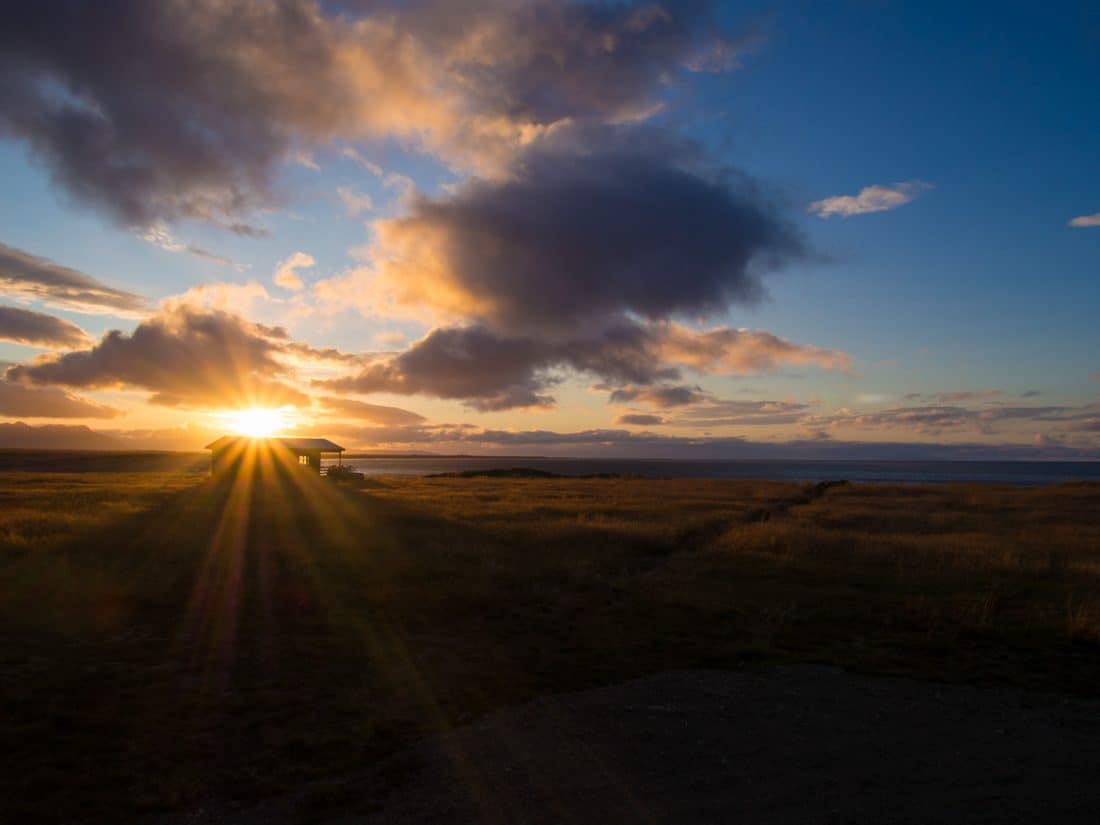
- Buy travel insurance – It’s essential in case anything goes wrong. We highly recommend True Traveller for UK and EU residents. Other options include SafetyWing (a budget option available worldwide), and Heymondo (available worldwide).
- Book the Blue Lagoon – Iceland’s most popular attraction can book up weeks in advance. It’s near the airport so most people visit after their flight arrives or before they depart. Book the Blue Lagoon with transfers here. We skipped it because it’s expensive, crowded, and we found some gorgeous, isolated hot springs in the Westfjords instead. Next time, I want to visit the new Sky Lagoon in Reykjavik, which should also be booked well in advance.
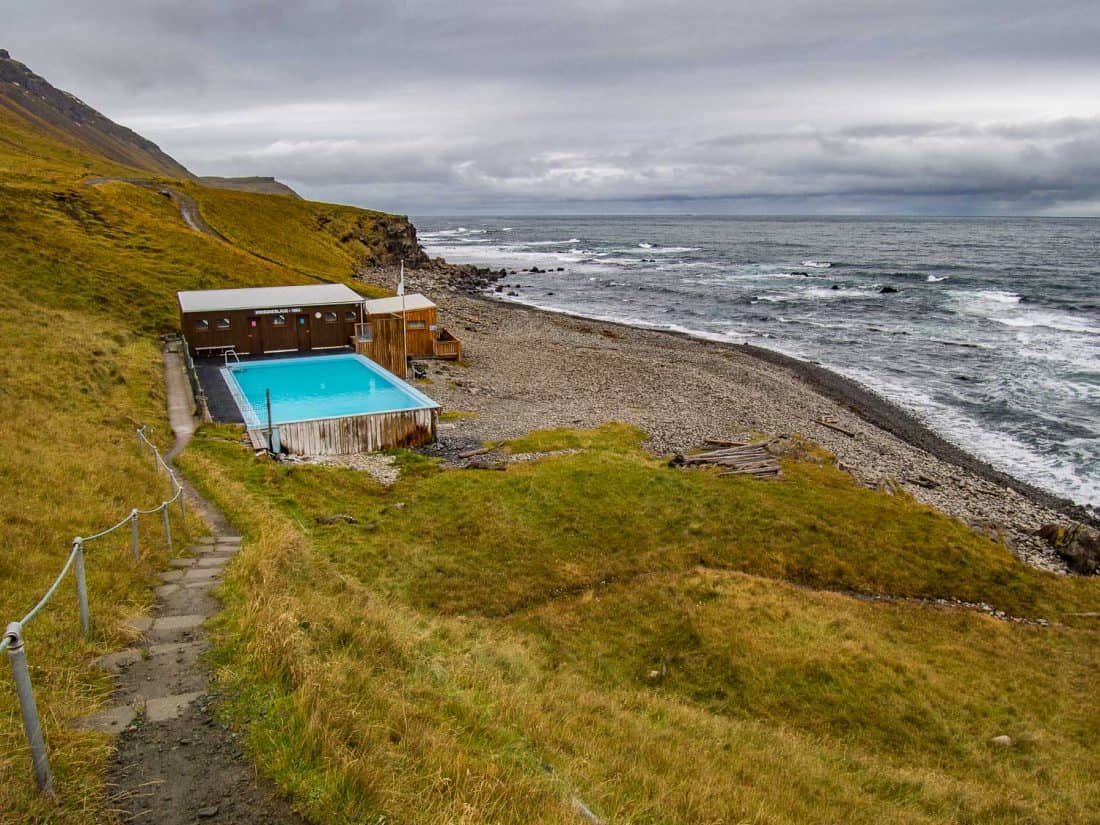
- Read The Little Book of Tourists in Iceland by Alda Sigmundsdottir – For tips by a local on travelling safely and responsibly and to understand the impact the tourism boom has had on the country. If you have time for more than one book, see my picks of the 10 best Iceland books to read before you visit including non-fiction and fiction.
- Pack the essentials – In every season you’ll need warm layers (merino wool is great), waterproofs, waterproof hiking shoes or boots, swimsuit and travel towel (for hot springs), tripod (for northern lights photography), and sunglasses (the sun is often low). See our Iceland packing list for what we took.
- Bring a chip and pin debit or credit card – You’ll need it for self-service petrol pumps.
- Don’t worry about cash – Cards are accepted everywhere. We only needed a small amount of cash on our Iceland trip (about 3000 Icelandic krona worth $21) for unattended hot springs and toilets.
- Read safetravel.is – For tips on staying safe on your Iceland vacation. You can also give them your travel itinerary so they’ll be able to respond if you don’t reach your planned destination.
- Check if an EITAS is required – From mid 2025 (but it keeps getting postponed), the EU will be introducing an online travel authorisation system for travellers from countries that are currently visa-free (including US, UK, and Canada). You’ll need to apply before your trip and pay €7 (valid for three years or until your passport expires).
Planning a Trip to Iceland: Dos and Don’ts
DO:
- Take the Icelandic pledge
- Be flexible – The volatile weather can mean tours are cancelled or hikes or drives would be too dangerous.
- Check road.is before setting out each day – For details of road conditions and closures.
- Take a walk through a lava field – They are incredible! Our favourites were on the Snaefellness Peninsula.
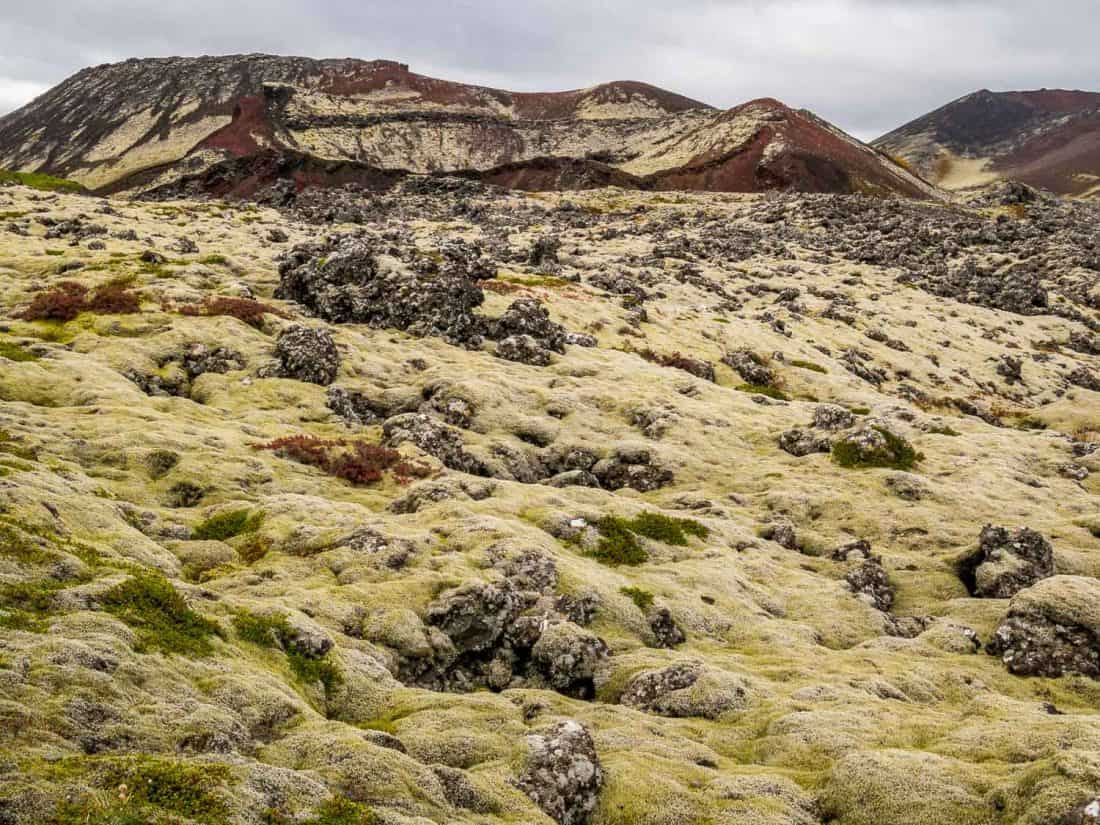
- Expect to see many waterfalls – They are everywhere! My favourite was Dynjandi in the Westfjords.
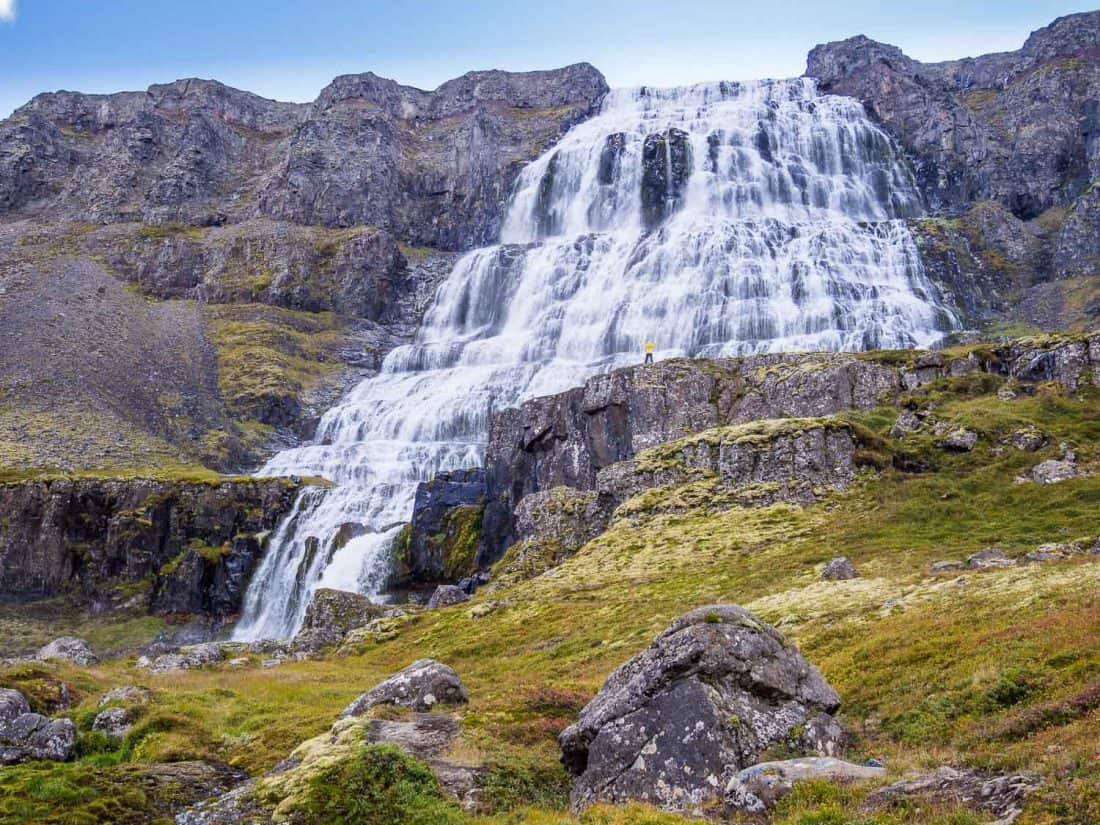
- Drink the tap water – It’s pure and delicious. Bring a lightweight, foldable water bottle like the Vapur with you.
- Look out for the northern lights from September to mid-April – We used the Aurora app and Vedur website to see our chances. We got lucky on a 30% chance day and saw them outside our Bjarkarholt cabin in the Westfjords. It’s best to stay in the countryside where there’s no light pollution. If you don’t have a car, you can take a northern lights tour from Reykjavik.
- Use a tripod and long exposure – To take photos of the northern lights. Most of mine were taken in manual mode at f2.8 with a 10 second shutter speed.
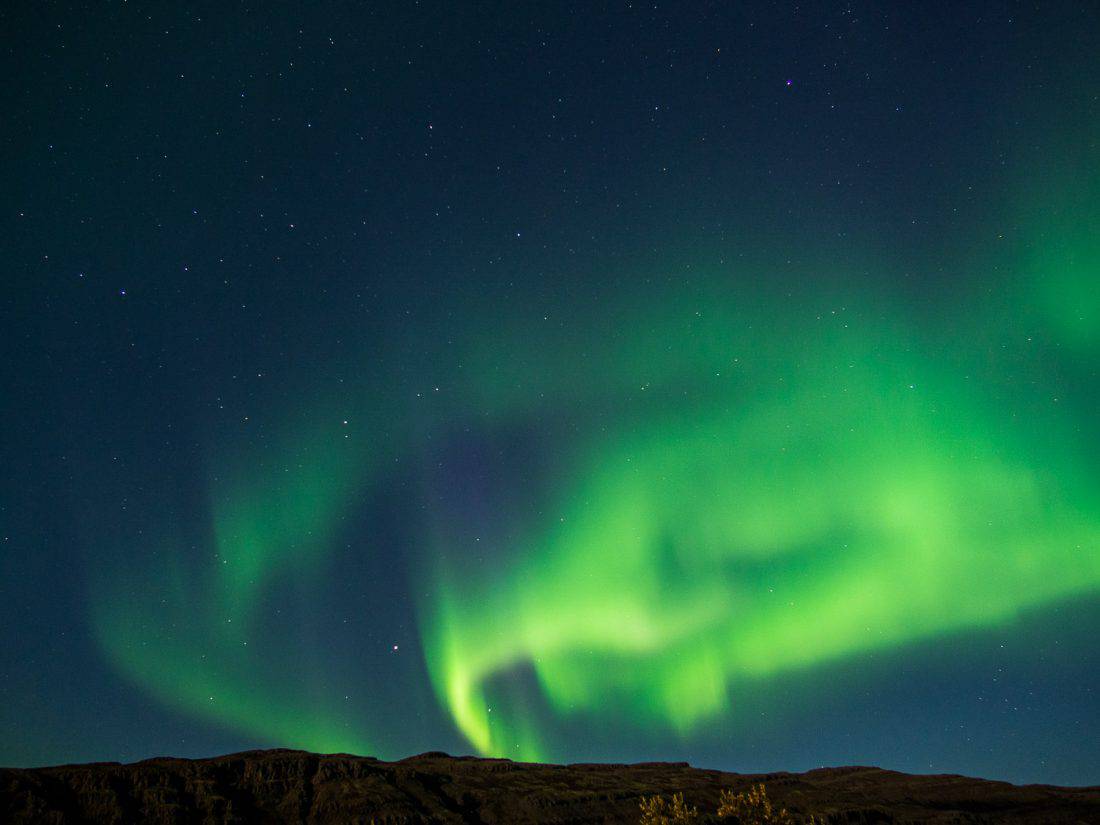
- Enjoy the midnight sun – If you visit Iceland in the summer when it’s light almost 24/7.
- Drive with your headlights on at all times.
- Be careful of sheep on the road – And always report it if you run one over (you won’t be fined).
- Fill up with petrol when you can – You might not come across a petrol pump for a while.
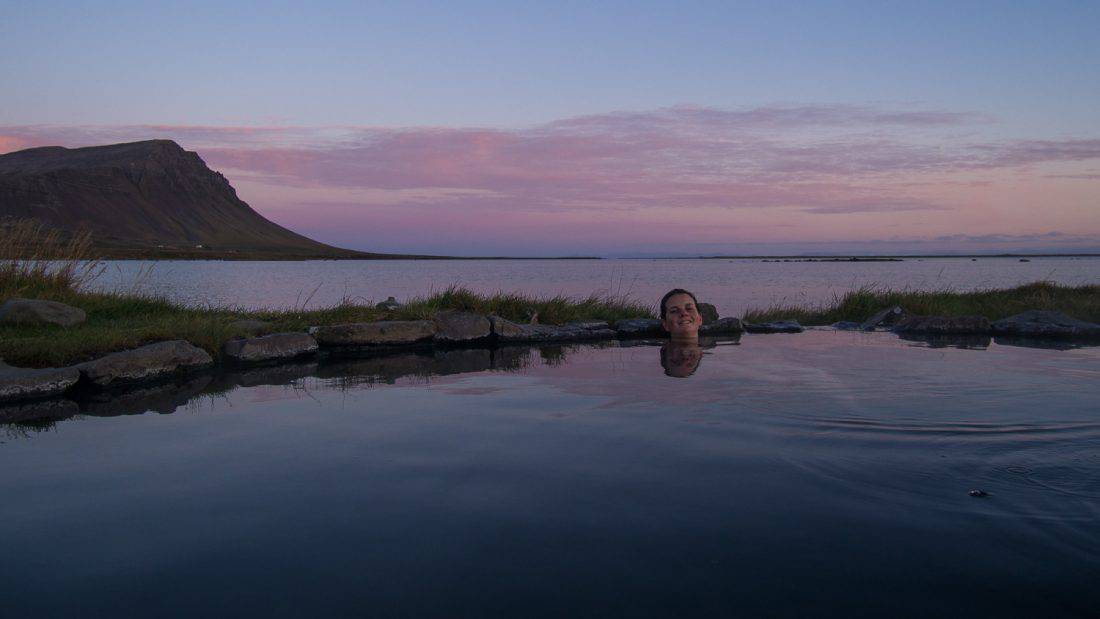
- Relax at geothermally heated swimming pools and hot pots – You’ll find them in even the smallest towns and it’s so lovely to swim in warm water when it’s cold outside.
- Shower naked thoroughly (without your swimsuit!) before entering a hot spring or pool – Public nudity isn’t a big deal in Iceland and you’ll draw far more attention to yourself if you don’t. They are very strict about this! There are separate male and female showers. You wear your swimsuit in the pool.
- Use the toilet whenever you find one (they are in short supply) – Be prepared to pay, usually around 200 ISK ($1.40). It’s worth keeping a small amount of cash for this.
- Admire the cute wooden churches everywhere.
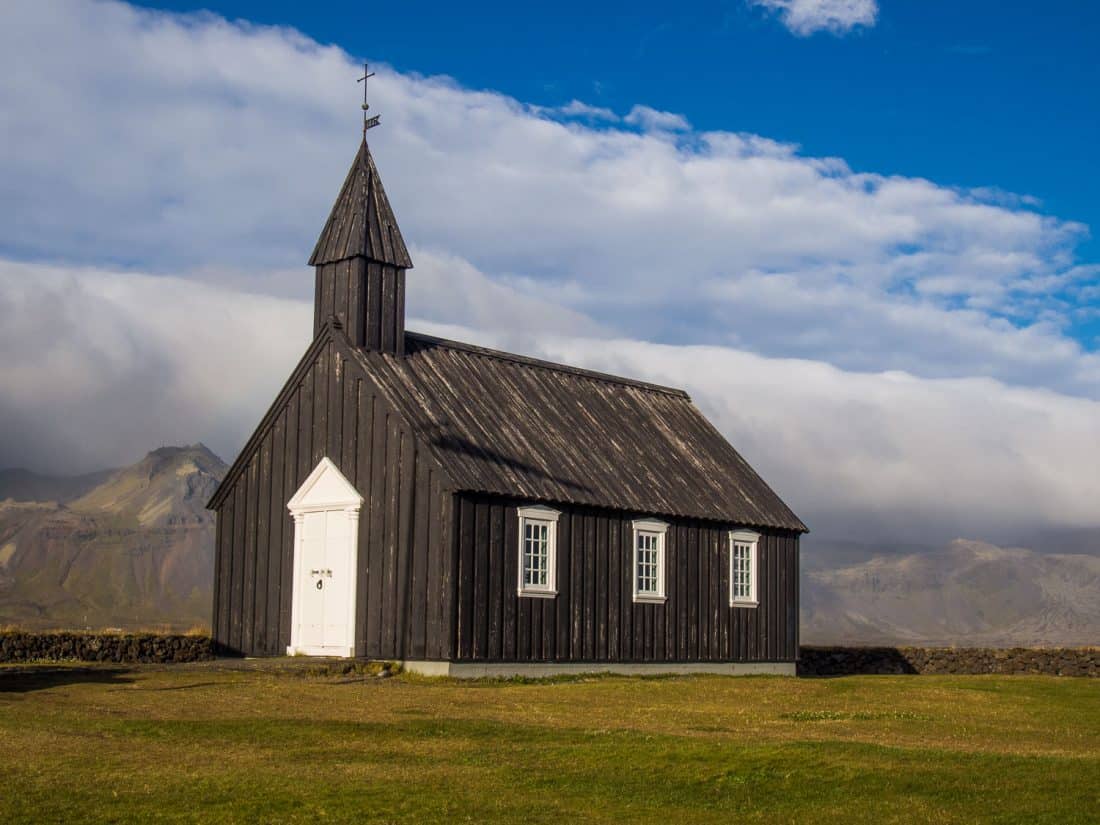
- Look out for seals – We saw them three times lazing on rocks by the sea.
- Ride an Icelandic horse and try its unique, smooth pace, the tölt.
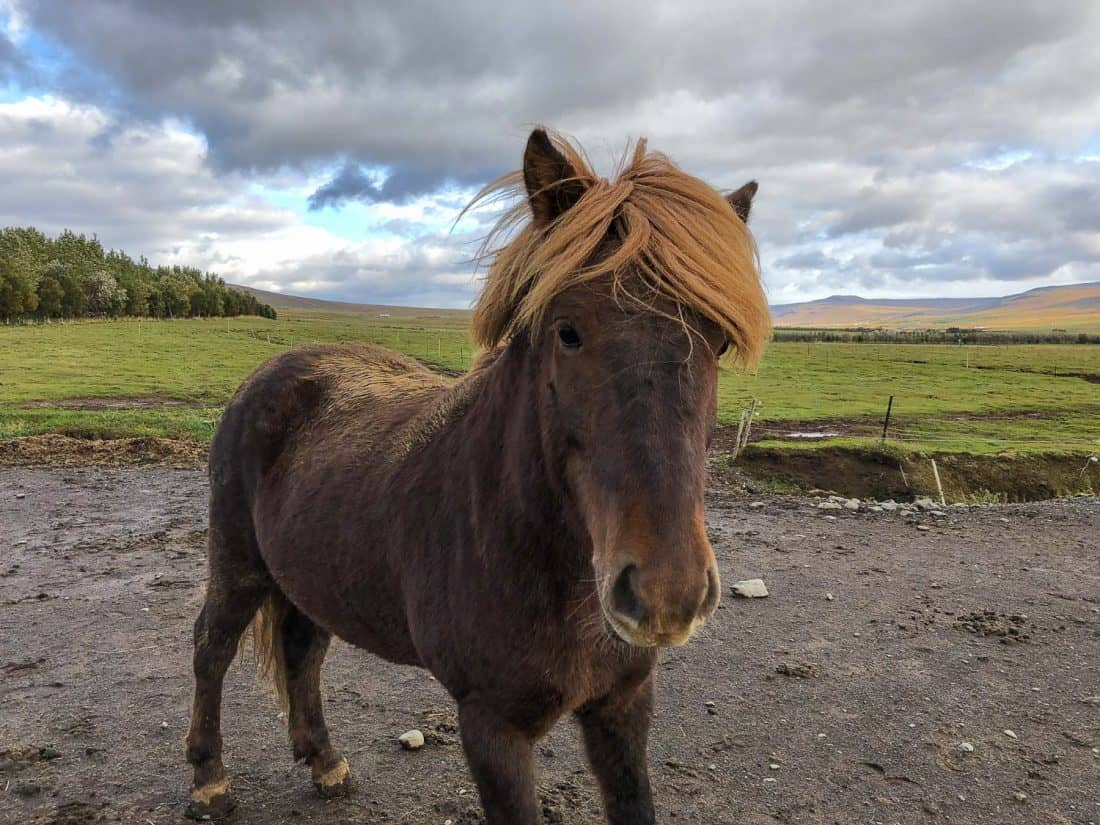
- Create a playlist of Icelandic music – I will forever associate Of Monsters and Men with epic drives through the mountains. Iceland has a huge number of talented bands—check out Björk, Sigur Rós, Solstafir, Ásgeir, Múm and many more.
- Read books by Icelandic authors – It’s a very literary country. Nobel Prize-winning Halldór Laxness is the most famous author, and reading the classic Icelandic Sagas from the 13th and 14th centuries will give you a greater understanding of the country as famous sites from the stories are everywhere. See my 10 favourite books about Iceland including fun, quirky, and mysterious novels.
- Take a walk on a beach – It’s unlikely to be sunbathing weather, but Iceland’s dramatic black, golden, and red beaches are perfect for wild walks.
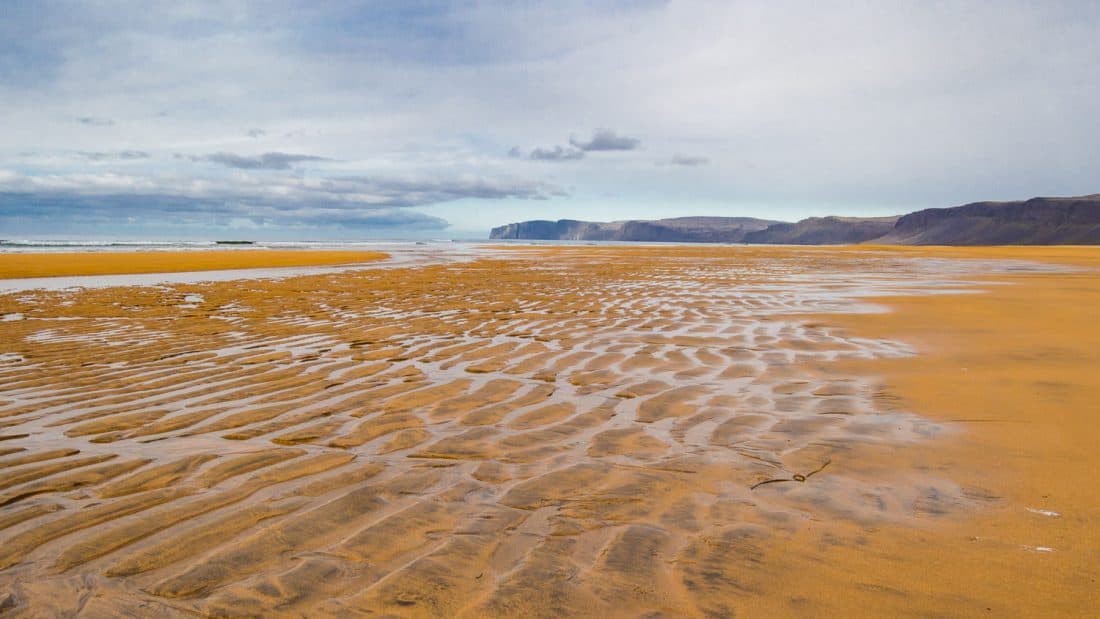
- Shop at Bonus supermarket – It’s the cheapest place to self-cater.
- Pack a picnic if you are road tripping – There often isn’t anywhere to stop for lunch, especially outside the summer when remote cafes close.
- Stock up on alcohol at Duty-Free on arrival at the airport if you want to drink – It’s much cheaper than in the state-run liquor stores (the only place you can buy booze).
- Enjoy delicious hot chocolate and cake (or a cinnamon bun) at one of Iceland’s excellent cosy cafes.
- Check Grapevine, a free English language newspaper – For what’s on in Reykjavik and enjoy its legendary nightlife and music scene on weekends.
- Call everyone by their first name – Titles aren’t used in Iceland. Instead of surnames, Icelanders use patronymics (or less commonly matronymics) made up of their father’s (or mother’s) name plus “son” (son) or “dóttir” (daughter). E.g. Björk Guðmundsdóttir is Gudmund’s daughter.
DON’T:
- Underestimate the weather – Icelandic weather changes fast and can be dangerous. Check the Vedur website or download their app for weather forecasts. Always be prepared with extra layers and waterproofs.
- Drive in a storm – Strong winds can blow cars off the road or volcanic rocks into your windscreen in scary sandstorms.
- Stop on the road – I understand, you will feel the urge to take a photo every few minutes, but always pull over into a parking area, even if the road seems empty.

- Speed – Stick to the speed limit of 50 km/h in urban areas, 80 km/h on rural gravel roads, and 90 km/h on rural asphalt roads.
- Feel the need to tip – It’s not rude to do so, but it’s not expected or customary.
- Wild camp – This is now banned and you must park your campervan or put up your tent in a designated campsite.
- Risk your life for a photo – Respect any barriers that have been put up.
- Get too close to cliff edges or the surf – Tourists have fallen off cliffs and been killed by rogue waves (especially at Reynisfjara beach).
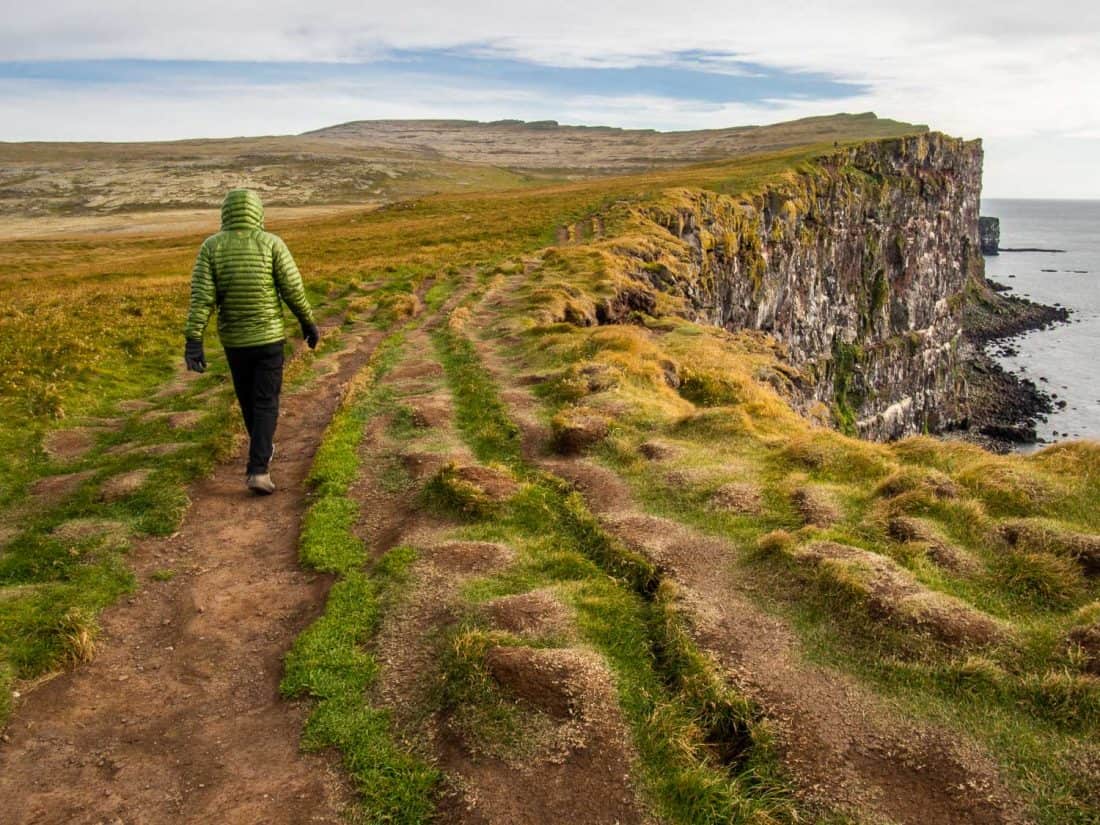
- Walk on the ice at Jökulsárlón glacier lagoon – The ice is not stable and the water is dangerously cold.
- Go onto a glacier without an accredited guide – There are hidden crevasses that you could fall into.
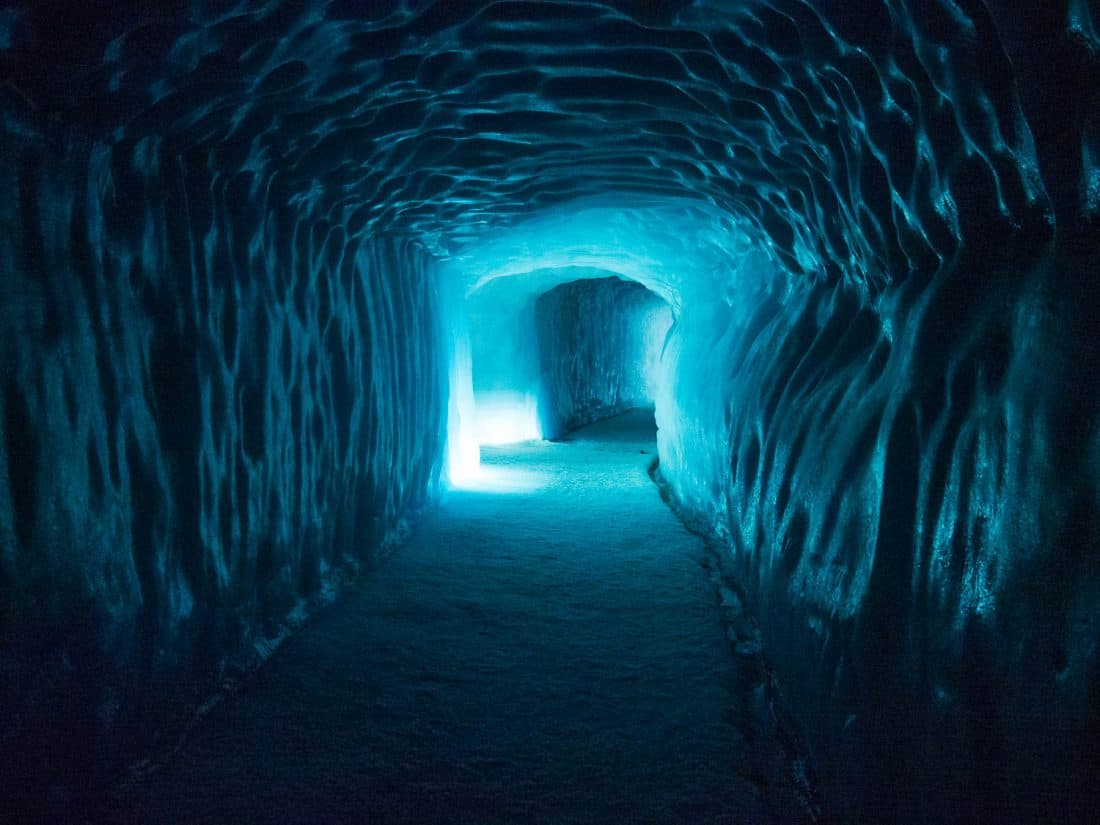
- Drive on F roads without a 4WD vehicle.
- Drive off-road in any vehicle – It damages the landscape and you’ll receive a high fine.
- Worry about staying connected – Even the remote cabins we stayed in had good WiFi and we had 3G or 4G signal almost everywhere. If you don’t have an affordable data plan for Iceland, buy an Airalo e-SIM and get online as soon as you arrive.
- Feed horses – Yes, they are cute, but it is bad for their health. It’s best to visit a horse farm like Sturlureykir, where can pay a small fee to interact with them (or go on a ride).
- Take rocks or pebbles as souvenirs.
- Litter – Have some respect for this beautiful place.
- Ask Icelanders if they believe in elves (aka hidden people) – The majority do not, although they understand that many of their ancestors did and they are part of their heritage.
- Rush – Iceland’s a stunning country, take your time and enjoy it.
I hope this post has answered any concerns about how to plan a trip to Iceland. Let me know if you have any questions in the comments below or share your own Iceland travel tips.
More Iceland Reading
- Iceland Itinerary: Off The Beaten Path on a Snæfellsnes and Westfjords Road Trip
- 14 Places Not to Miss on the Snaefellsnes Peninsula
- How Much Does an Iceland Trip Cost? Our Road Trip Budget
- 10 Best Books About Iceland to Read Before You Visit
- The Ultimate Iceland Packing List for Men and Women
- Visiting Iceland in September: What to Expect and Things to Do
If you enjoyed this post, pin it!
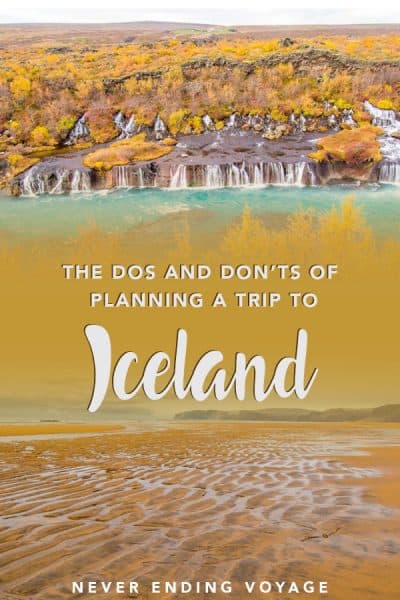
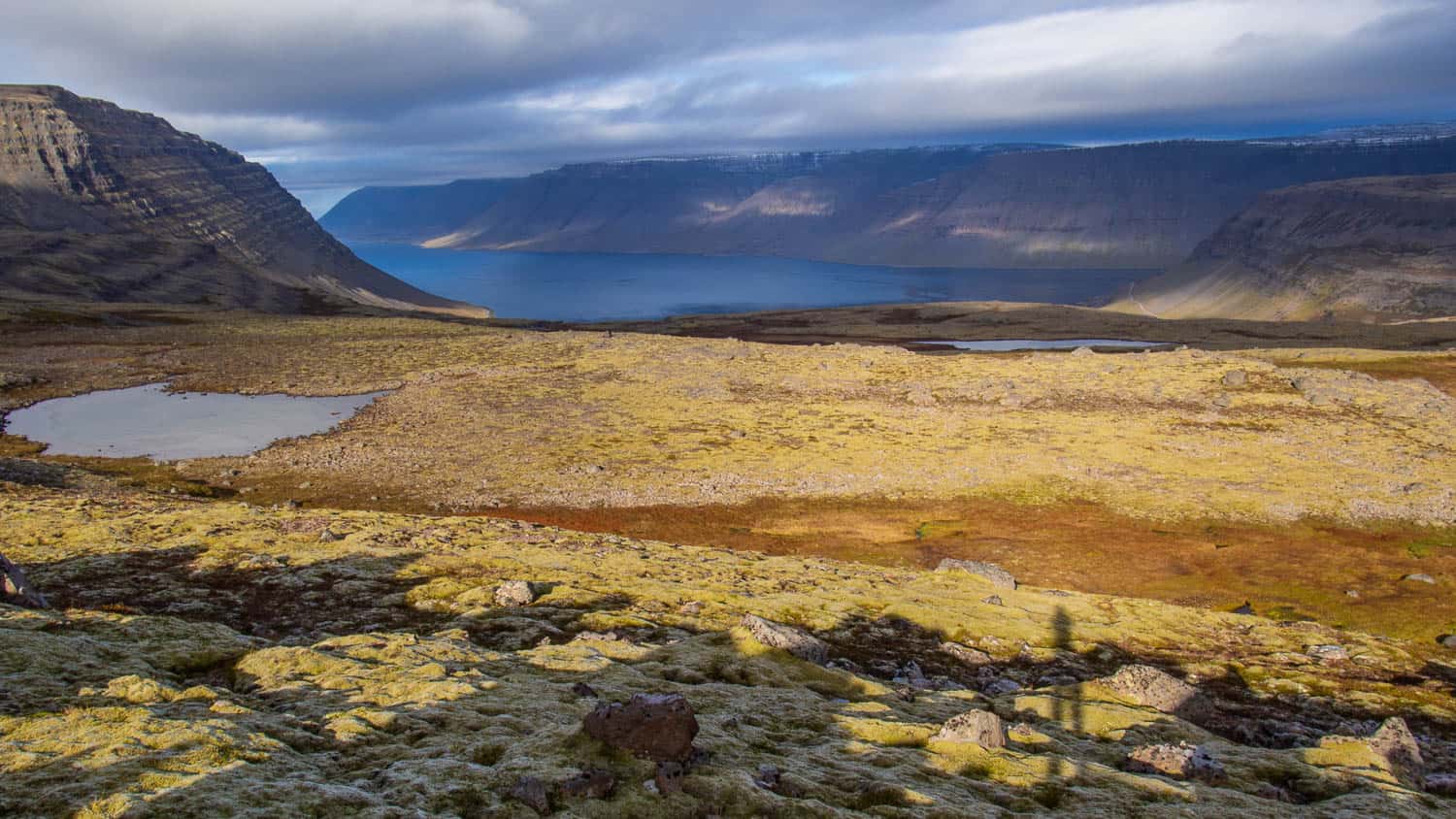
We’re planning a one way cruise to Iceland from the US for 2025. The cruise excursions are really expensive, are there guides to contact to make our own excursion plans?
Also planning to stay an extra few days then fly back to US
I’m sure there are guides but I don’t have any contacts. You could also look at sites like Get Your Guide (linked to in this post) and see if any of the many tours listed there would work for you. Enjoy!
I am currently planning a summer Iceland trip, is there a certain part of Iceland (city/location) or an activity that can only be accessed through a tour like a hike, whale watching, etc. that should not be missed? This will be my first time in Iceland. Thank you!
Hi, great blog. I’m thinking of taking my 3 teenagers to Iceland. I don’t want to be stuck in the hustle of a “tour group” experience. Is it possible to do it on my own with just day trips? How is late June? Will we be able to see glaciers and ice caves or are those only in the winter? Thanks!
Yes, you could do it on your own with day trips if you hire a car and don’t mind a fair amount of driving.
In this case, you might also want to consider a night or two outside Reykjavik though–the Snafellsness peninsula is only a few hours away and is worth the extra time.
Late June is busy and expensive (book asap), but the weather is at its best (but still be prepared for cold) and you’ll have up to 21 hours of daylight.
Langjokull Ice Cave is on a glacier and can be visited year round as it’s man made. You have to visit on a tour from Husafell or Reykjavik.
Enjoy Iceland!
I loved your article. I would like to ask: is it possible to visit Iceland on day tours from Reykjavik? Or is it better to take a 6 days tour of the country? Is it possible to rent a bus from Reykjavik for a group of people?
You wouldn’t be able to see the whole island, but I wouldn’t recommend trying to do that in 6 days anyway. You can certainly see a lot by taking day tours from Reykjavik. Many people who don’t want to drive do this.
I’m not sure about renting a bus. But if you have a really big group maybe contact an Iceland tour company for advice. Organising a private tour might make more sense than joining a group tour.
Credit card use is very pervasive.
However at campsites where laundry and showers are coin-operated, how does one get the coins needed?
We haven’t stayed at campsites so I’m not sure, but we withdrew a small amount of cash from an ATM at the airport on arrival.
Very good article, we just returned from our two weeks in Iceland. and the only thing I would add it’s the wind, not the temperature that is hard to handle. Plus all the Icelandic people we delta with all spoke perfect English, a couple of times I had to ask them where they were from, only to be shocked that they were from Iceland.
Enjoy your trip, we did, oh and make sure you get full car insurance!
It’s really helpful for my Christmas Iceland Trip! I hope I can experience a lot as you said!
Thank you very much, Erin, for this super informative blog. I’m planning to visit Iceland sometime in Feb/Mar 2023.
Will visit the places of interests you shared. We come from Singapore – hot climate. Might be a struggle to keep ourselves warm in Iceland. :-(
Great information, You answered all my questions
Planning a trip to Iceland now and this has been a super helpful place to start! Thanks so much for a really awesome guide. Reading your 5-day Winter itinerary next as we’re going February 2022 so that could be perfect for us!
Thank you. Very informative, organized, and superb photography.
Thanks, Jay!
After spending 18 months sequestered and being fully vaccinated, I did an 8-day tour of Iceland and although it was challenging getting there from Western Canada, once I got there I loved it! I can verify all the recommended do’s & don’ts are true and worth your while following. The landscape is like no other in the world and it took my breath away despite not having the best weather. The people very friendly & welcoming, the food amazingly delicious, hotels & accommodations modern, simple & comfortable. Our tour and our guide was amazingly knowledgeable & experieced who kept us entertained with great facts, history, geology, birding knowledge & some tall tales. Loved it and would visit again!
Thanks for the trip report, Aida! It sounds like an amazing trip! You’re making me really want to go back.
Are the travel restrictions for Vaccinated people lifted for Iceland? FYI: I’m an american
Yes, you can travel to Iceland now.
I can’t wait to move to Iceland
Hi,
I’m an American, do you think the travel restrictions will be lifted by the summer?
Thank you,
Jessica
No one really knows but it will depend if the US can get the virus under control by then. It looks like from 1 May, Iceland hopes to open up a little more but that will be based on each country’s situation. Edit: All restrictions have been lifted.
Personally I wouldn’t book anything unless you have free cancellation.
Hi Erin. Thanks for this guide. My wife and I are planning a trip there in September or October. We are US Citizens, so we hope it can happen. We have travel certificates which expire at the end of the year, so we are sort of up against a wall. We have to check to see what the cancellation policy is. Fingers crossed that it can happen.
Paul
Good luck with it! It’s so hard to say what will happen with travel this year.
HELLO
Maby
Thank you very much for this guide! I’ve been looking at pre-paid packages and trying to decide whether to do one of those or create my own.
Do you have any advice for a solo female traveler? It’s my first solo trip and I am excited but nervous.
I don’t have any experience of solo travel in Iceland but it’s a very safe country and we know plenty of women who loved it. Probably the easiest way would be to stay in Reykjavik and take day tours. If you are a confident drive you could also rent a car and head off by yourself. It’s pretty easy to arrange your own trip. Enjoy!
we are planning a trip this summer. thanks for all the information!
Enjoy, Elana!
The pics are literally breathtaking. Can’t wait to see it all with my own eyes next summer. Thank you for the tips, really valuable for me planning my first encounter with this beauty.
It is one of the most stunning places we’ve ever visited. Have an amazing trip!
This is a great resource! Thanks so much for taking the time to put it together. I particularly appreciate the tips regarding the need for a credit/debit card with a chip and pin for buying gas/petrol, the custom for gratuities, the Icelandic music playlist (perfect for the road trip!) and reading suggestions, and where to buy alcohol and groceries. And my favorite tip is to enjoy the hot chocolate and cake…don’t need to tell me twice!
I’m so glad you found it useful Heather!
Good list! I have two comments:
– Love the thing about tipping! During my trip, I actually asked one waitress what would be an appropriate tip and she said: “We have normal wages here, we don’t need tips”. ??
– I tried to read Independent People by Laxness while in Iceland but I had to give up. There’s only so much interest I can muster about the sheep… ?
Ha! I haven’t read Independent People yet as I heard The Fish Can Sing is a more accessible, lighthearted introduction to Laxness and I did enjoy it.
Erin what a rocking list. All noted. Iceland reminds me somewhat of New Zealand. Insane beauty, kinda expensive and yep, gotta have you head on a swivel sometimes. Especially driving.